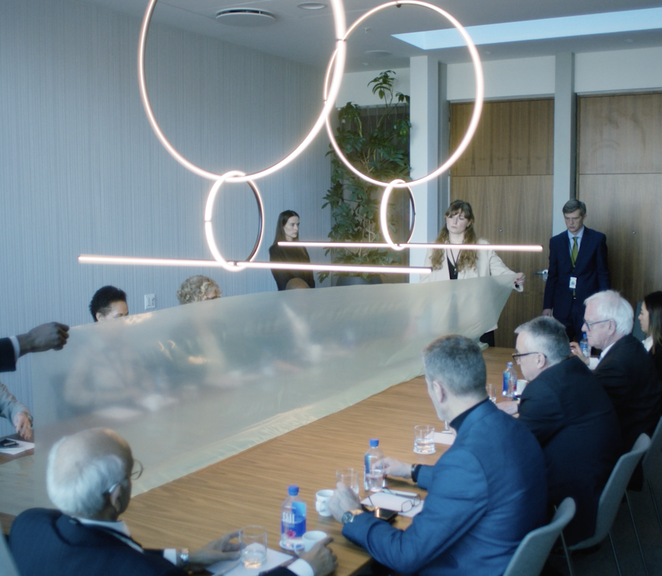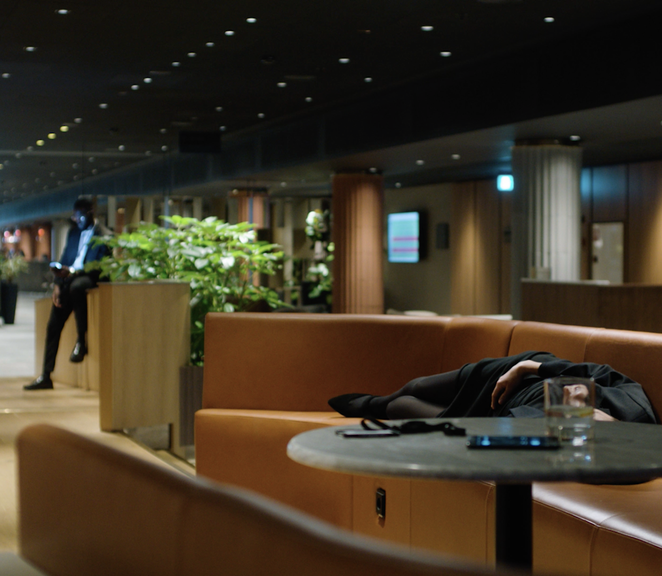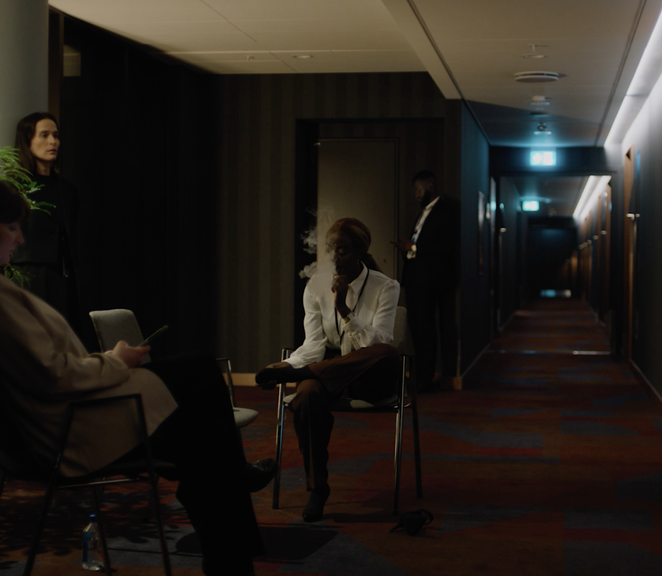On the Work of Melanie Gilligan
In Melanie Gilligan’s video series 'Popular Unrest' from 2010, the linkage between horror fiction and finance is quite outspoken. Exploring the relationship between capitalism and biopower, the work revolves around an invisible system of algocratic control called the Spirit, that monitors its denizens, assigning them ratings based on their personal 'market indicators'. A group of denizens are surveyed and monitored, by researchers from neuroscience, psychology and computer science, in search of ways to communicate with the Spirit, through the potentials of group-psychology. Parallel to this, random people (presumably calculated to be expendable) are being killed by the Spirit. Similar to many of her other works, like 'Crisis in the Credit System' (2008) or 'Self-Capital' (2009), 'Popular Unrest' is formatted much like an episodic drama on contemporary prime time or cable television. The actors perform in a way that is distinct to the genre and it immediately moves the storytelling into a humorous setting, where the parody or paraphrasing of the television medium always colour the content. This format also allows for a more alarming quality. There is something essentially real to the tv-performance. The way the actors, act like television actors, makes the whole thing come out weirdly authentic. The obvious dramatisation of the real, somehow takes the place of reality. This use of television drama directing, somehow bypasses the pursuit of replacing reality through convincing cinema, and cuts straight to the convincing proposal to just accept it as real. Furthermore this format offers a very natural space for descriptive narration. The actors act out interview situations, describing their inner conflicts and observations verbally; long explanatory monologues abound; situations are outspoken as they occur by overlayed comments or outspoken reactions to a moment. And it all comes out natural, because it is such a well-known trait of the genre and medium. Gilligan seems to use this factor, quite consciously, especially in the instances when she breaks away from it. The murder scenes are the most obvious examples of this. In these kitchen knives levitate in the air by themselves, wielded by no hand. Somewhat clumsily they just hang there in the air, crudely attached to the space, before they plunge down on an unsuspecting character. Cut to, close up of gore; a sort of generic pile of meat and blood, being stirred in and chopped at by the knife. Not really applied special effects, rather analogical placeholder of such an effect. We do the visual math ourselves and completes the visceral gore fest.
I relate tremendously to the work of Gilligan and I reflect my own work in hers, in three specific ways. One, the way that the dramatisation is revealed to be a construct and in this aim at bypassing the illusion for a more conscious acceptance of construction as reality. Two, the way that the socio-political realm spun around modern finance is described in a fantastical optic, where the weird (and the eerie) co-exists with dead-pan everyday motions. And three, the way genre is used deliberately to circumvent conventions in the field of video art. But in each of these connections, there are differences in approach.
Where Gilligan chooses the television format, that instantly moves her work away from cinema, I choose in my work to stay within the cinematic. I am interested in approaching that illusionist space of cinema; brush up against it, enter it and then at moments strangely glitch out of it. I deliberately make use of many of the tools in the production of a cinematic reality, and only do little shifts in its logic in order to arrive somewhere else. When I say, cinematic reality, I am referring to a certain condition or mood, that is visually and experientially recognised and shared by most, on account of how contemporary reality is often reflected in and mediated through a certain cinematic format. In the same way that Gilligan pushes away from the television medium by introducing moments of different experimental material (the gore), I perform swerves inside the totality of the illusion, steering clear of its transfixing hold. These take the form of revelations of the construct of the illusory condition: The machinery of the production literally visible in the frame (dolly tracks, crew-members, body-cams, set pieces etc.); unrehearsed acting making the delivery of dialogue trail or waver; shifts in technical mediums, distorting the high production value feel of a thing as it passes to lower resolution cameras, filtering, computer generated augmented realitiy or hard cuts to obviously computer generated sequences. The swerve is there to create cognition around the act of experiencing, and hopefully from here accept this cognitive form of emergence.
Where the fantastical dimensions of Gilligan’s work most often is an integral part of the narrative, quite directly shaping a space of metaphors that comment on the realm of neoliberal politics and economy, I try to let the fantastical create more of a kind of undertow. I have been more and more interested in merely letting the socio-political field of inquiry, set a scene from where a certain fantastical dimension can arrive, i.e. a conference set in the world of finance, that sets the scene for something other and foreign to emerge. This fantastical dimension can be summoned by a shift in the nature of things on screen, most presently in the temporality of this nature. Moments of extended duration, actions repeating ,looped narrative structures, shifts in tempo, or edits that bluntly fall onto the floor. The narrative structure is there, but it is a deliberate choice that this narrative often seeps out into more folded and circular timelines, loosing track of the linear story, and rather moving towards the shaping of a mood or condition.
Gilligan makes use of the episodic dramas of television to create her own style of video art installations (emphasised in the way she installs her work on flatscreen monitors attached to sculptural metal grits; the scaffolding-like structures connecting each screen, forming placeholders for an imagined programmed duration in-between episodes). Her use of the horror genre is arguably an adaptation of its plot-driven structure, leading up to a confrontation with the monstrous entity of The Spirit. A climactic resolution. In contrast, my work is informed by the horror genre in a more un-evental way, closer related to a temporal nature, latent and immanent to the genre. It isn’t about a monster of horror serving as metaphor for Absolute Capitalism, what The Spirit could arguably be in 'Popular Unrest', it is about attempting to stay with the horror aspect, monster aside. Utilising recognisable traits and rhythms of the genre, to enable explorations into the horror of finance, always refraining from pinning it on an actual monster. An acknowledgement of the way that this monstrosity is really absolute and that the severing of one of its tentacles will only outgrow a new. Without a monster this financial realm shapes an absolute condition and to counter-act within this, one must first learn to exist within it (to survive the night in its haunted mansion) and from here perform sabotage-acts of stupidity and chaos.
-
contents
- The Wall
- Soft Hands
- Introduction
- Navigation
- Methodology
- Transrealism
- Tempor(e)ality
- Meanderer
- Atmosphere
- Horror
- Horror in The Fabric
- Sublime Now
- Beyond Real and Abject
- Finance
- Absolute Capitalism
- Finance as Horror Stage
- "Popular Unrest"
- Event
- Prolonged Now
- Auto-symbolisation
- Messy Extimacy
- "Anhell69"
- Fieldnotes from Island
- Island of Trash
- Suicide Slide
- Iguana POV
- Cable ITCH
- Necklace
- Staircase
- In The Hall of the Mountain King
- Field Notes from Archipelago
- Archipelago - No One is an Island
- Gore rig
- Mumblegore
- Prosthesis
- The Pit
- Cathedraltown
- Hand Signals
- Splash
- Temps Morte
- Rebootism
- Bull and Bear
- Subtle Background Scare
- Oceanic Horror
- WORKS
- Literature and Sources
- APPENDIX
- Soren Thilo Funder
-
navigation
-
abstract
Søren Thilo Funder PhD in Artistic Research University of Bergen Faculty of Fine Art, Music and Design The Art Academy – Department of Contemporary Art Supervisors: Daniel Jewesbury, Darla Crispin, Anne Helen Mydland and Frans Jacobi. Artistic reflection and documentation of artistic result submitted in partial fulfillment of the requirements for the degree of Philosophiae Doctor (PhD) in Artistic Research at the University of Bergen. Date of public defence: 8.12.2023 'Oceanic Horror - or How to Survive the Night in the Haunted Mansion of Absolute Capitalism' is an artistic research project that explores the potentials of utilising the genre of horror fiction to create new narratives in a political and time-based art practice. It is invested in the temporal qualities and entanglements of the horror genre and how these relate in strange ways, not only to our current tempor(e)ality and the modes of financialisation that informs this, but also to art practices using the temporal as material. Framed around the revisiting of the mid-nineties trading firm 'Island' in the advent of high frequency trading and its successor the trading company 'Archipelago', pushing the algorithmic trading systems further into the splash of web 2.0, 'Oceanic Horror' uses the methodologies of Transrealism and Meandering to create new nonlinear narrations revolving around the relationship between the opaque structures of absolute capitalism and the socio-political horror experienced in everyday life. The research project searches for a certain condition found in horror fiction, that relates to its relentless nowness, its proposed prolonging of this now, its relation to eventality and the quasi-event and finally how horror fiction wants to do things to the body - not only in a simple reaction mode but really in the very temporality experienced in and by the body. The artistic result of 'Oceanic Horror' was exhibited at Kunsthall 3.14 in Bergen 21.04.2023 - 04.06.2023, comprising a multi-channel video installation combining digital renderings with fictional cinematic scenes in an immersive total installation of office furniture sculptures forming makeshift sleep stations in the exhibition space. The reflection for 'Oceanic Horror' is presented in this Research Catalogue exposition, including both written material, images and a comprehensive archive of all the video works that make up the entangled narratives of 'Oceanic Horror - or How to Survive the Night in the Haunted Mansion of Absolute Capitalism' Norwegian: 'Oceanic Horror - or How to Survive the Night in the Haunted Mansion of Absolute Capitalism' er et kunstnerisk forskningsprosjekt som utforsker mulighetene i sjangeren skrekkfiksjon til å skape nye utrykk og narrativer i politisk og tidsbasert kunstpraksis. Prosjektet utforsker skrekksjangerens temporale oppbyggning, estetikk og kvaliteter. 'Oceanic Horror' anvender både som kunsteriske metoder og utrykk 'transrealisme' og 'meandering' for å skape nye ikke-lineære fortellinger og kunst som dreier seg om forholdet mellom de ugjennomsiktige strukturene i 'absolutt kapitalisme' og den sosio-politiske 'horroren' som oppleves i hverdagen. Med utgangspunkt i historien om det reelle handelsfirmaet 'Island', som i midten av nittitallet var med i oppstarten av høyfrekvent aksjehandel, og dens etterfølger, selskapet 'Archipelago', som ledte bølgen av algoritmiske aksjehandelssystemer i web 2.0, søker forskningsprosjektet etter en viss tilstand som finnes i horror fiction, som relaterer seg til dens nådeløse nåhet, dens foreslåtte forlengelse av dette 'nå', dets forhold til 'event' og 'kvasi-event' og hvordan horror fiction ønsker å gjøre ting med kroppen - ikke bare i en enkel reaksjonsmodus, men egentlig i selve temporaliteten som oppleves i og av betrakterens kropp. Det kunstneriske resultatet av 'Oceanic Horror' ble vist på Kunsthall 3.14 i Bergen 21.04.2023 - 04.06.2023. Utstillingen besto av en flerkanals videoinstallasjon som kombinerer digitale gjengivelser med fiktive filmatiske scener. Vist i en totalinstallasjon av kontormøbelskulpturer som danner provisoriske sovestasjoner i utstillingsrommet. Den kunsteriske refleksjonen som følger 'Oceanic Horror' presenteres på Research Catalogue og inkluderer både tekster, bilder og et omfattende arkiv av alle videoverkene som utgjør de sammenfiltrede fortellingene til 'Oceanic Horror - or How to Survive the Night in the Haunted Mansion of Absolute Capitalism'
- Soren Thilo Funder - Oceanic Horror or How to Survive the Night in the Haunted Mansion of Absolute Capitalism - 2024
- Meta
- Comments
- Terms


